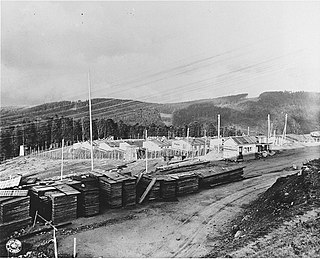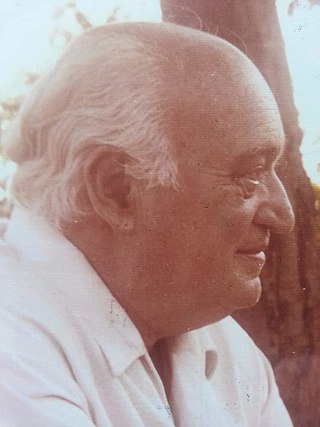
Bergen-Belsen, or Belsen, was a Nazi concentration camp in what is today Lower Saxony in northern Germany, southwest of the town of Bergen near Celle. Originally established as a prisoner of war camp, in 1943, parts of it became a concentration camp. Initially this was an "exchange camp", where Jewish hostages were held with the intention of exchanging them for German prisoners of war held overseas. The camp was later expanded to hold Jews from other concentration camps.

Natzweiler-Struthof was a Nazi concentration camp located in the Vosges Mountains close to the villages of Natzweiler and Struthof in the Gau Baden-Alsace of Germany, on territory annexed from France on a de facto basis in 1940. It operated from 21 May 1941 to September 1944, and was the only concentration camp established by the Germans in the territory of pre-war France. The camp was located in a heavily-forested and isolated area at an elevation of 800 metres (2,600 ft).

Mauthausen was a Nazi concentration camp on a hill above the market town of Mauthausen, Upper Austria. It was the main camp of a group with nearly 100 further subcamps located throughout Austria and southern Germany. The three Gusen concentration camps in and around the village of St Georgen/Gusen, just a few kilometres from Mauthausen, held a significant proportion of prisoners within the camp complex, at times exceeding the number of prisoners at the Mauthausen main camp.

Rudolf Franz Ferdinand Höss was a German SS officer during the Nazi era who, after the defeat of Nazi Germany, was convicted for war crimes. Höss was the longest-serving commandant of Auschwitz concentration and extermination camp. He tested and implemented means to accelerate Hitler's order to systematically exterminate the Jewish population of Nazi-occupied Europe, known as the Final Solution. On the initiative of one of his subordinates, Karl Fritzsch, Höss introduced the pesticide Zyklon B to be used in gas chambers, where more than a million people were killed.

Therese Brandl was a Nazi concentration camp guard.

Maria Mandl was an Austrian SS-Helferin known for her role in the Holocaust as a top-ranking official at the Auschwitz-Birkenau extermination camp, where she is believed to have been directly complicit in the deaths of over 500,000 prisoners. She was executed for war crimes.

During the Dachau liberation reprisals, German SS troops were killed by U.S. soldiers and concentration camp prisoners at the Dachau concentration camp on April 29, 1945, during World War II. It is unclear how many SS men were killed in the incident, but most estimates place the number killed at around 35–50. In the days before the camp's liberation, SS guards at the camp had forced 7,000 inmates on a death march that resulted in the death of many from exposure and shooting. When Allied soldiers liberated Dachau, they were variously shocked, horrified, disturbed, and angered at finding the massed corpses of prisoners, and by the combativeness of some of the remaining guards who allegedly fired on them.

Josef Kramer was Hauptsturmführer and the Commandant of Auschwitz-Birkenau and of the Bergen-Belsen concentration camp. Dubbed the Beast of Belsen by camp inmates, he was a German Nazi war criminal, directly responsible for the deaths of thousands of people. He was detained by the British Army after the Second World War, convicted of war crimes, and hanged on the gallows in the prison at Hamelin by British executioner Albert Pierrepoint.

Franz Hößler, also Franz Hössler was a Nazi German SS-Obersturmführer and Schutzhaftlagerführer at the Auschwitz-Birkenau, Dora-Mittelbau and Bergen-Belsen concentration camps during World War II. Captured by the Allies at the end of the war, Hößler was charged with war crimes in the First Bergen-Belsen Trial, found guilty, and sentenced to death. He was executed by hanging at Hameln Prison in 1945.

During the Holocaust, death marches were massive forced transfers of prisoners from one Nazi camp to other locations, which involved walking long distances resulting in numerous deaths of weakened people. Most death marches took place toward the end of World War II, mostly after the summer/autumn of 1944. Hundreds of thousands of prisoners, mostly Jews, from Nazi camps near the Eastern Front were moved to camps inside Germany away from the Allied forces. Their purpose was to continue the use of prisoners' slave labour, to remove evidence of crimes against humanity, and to keep the prisoners from bargaining with the Allies.

Anton Thumann was a member of the SS of Nazi Germany who served in various Nazi concentration camps during World War II. After the war, Thumann was arrested by British occupation forces and charged with war crimes. At the Neuengamme Camp Case No. 1 in 1946 he was found guilty, sentenced to death and executed at Hamelin Prison.

The Buchenwald trial or United States of America vs. Josias Prince of Waldeck et al. was a war crime trial conducted by the United States Army as a court-martial in Dachau, then part of the American occupation zone. It took place from April 11 to August 14, 1947 in the internment camp of Dachau, where the former Dachau concentration camp had been located until late April 1945. In this trial, 31 people were indicted for war crimes related to the Buchenwald concentration camp and its satellite camps, all of whom were convicted. The Buchenwald trial was part of the Dachau trials, which were held between 1945 and 1948.

Boelcke-Kaserne concentration camp was a subcamp of the Mittelbau-Dora concentration camp complex where prisoners were left to die after they became unable to work. It was located inside a former Luftwaffe barracks complex in Nordhausen, Thuringia, Germany, adjacent to several pre-existing forced labor camps. During its three-month existence, about 6,000 prisoners passed through the camp and almost 3,000 died there under "indescribable" conditions. More than a thousand prisoners were killed during the bombing of Nordhausen by the Royal Air Force on 3–4 April 1945. Their corpses were found by the US Army units that liberated the camp on 11 April. Photographs and newsreel footage of the camp were reported internationally and made Nordhausen notorious in many parts of the world.

During World War II, the German Luftwaffe staffed dozens of concentration camps, and posted its soldiers as guards at many others. Camps created for the exploitation of forced labor for armaments production were often run by the branch of the Wehrmacht that used the products. The Wehrmacht also posted about 10,000 soldiers to concentration camps because of a shortage of guards in mid-1944, including many from the Luftwaffe.

Stefan Baretzki was an Auschwitz guard of Bukovina German origin. He was conscripted into the Waffen-SS and stationed at the Auschwitz concentration camp from 1942 until 1945. There he participated in the mass murder by making selections, beatings and murdering prisoners on his own initiative. After the war, Baretzki settled in West Germany. He was the lowest-ranking of the twenty-four defendants in the Frankfurt Auschwitz trials. His murders were sensationalized in the German press, taking the focus off of the systematic crimes of the Nazi regime. The court sentenced him to life imprisonment and eight years for participating in the murder of more than 8,000 people. Baretzki expressed regret for his actions, testified against his former superiors, and committed suicide while serving his sentence.

Johann Schwarzhuber was a German SS-Obersturmführer, who was in charge of various concentration subcamps during World War II. His positions included the Schutzhaftlagerführer of the Auschwitz-Birkenau men's camp, where he oversaw the selection process for the gassing of thousands of detainees. He was later transferred to the Ravensbrück concentration camp, where he held the post of the Lagerdirektor, second only to the overall camp commander Fritz Suhren. With Suhren on the run, Schwarzhuber was the highest-ranking defendant during the first Ravensbrück trial. In front of the British military tribunal he was indicted for war crimes, sentenced to death and subsequently executed in 1947.
Bruno Brodniewicz born 22 July 1895 in Posen, was a German prisoner in the Auschwitz concentration camp. Brodniewicz was the first Lagerälteste, carrying prisoner tag number 1. He died in April 15–16, 1945 in Bergen-Belsen concentration camp.

Edgar Kupfer-Koberwitz was a German journalist, poet and prisoner in the Dachau concentration camp. He was the author of the Dachau Diaries, in which he describes the events in the concentration camp, the SS Camp and the prisoner society.





























